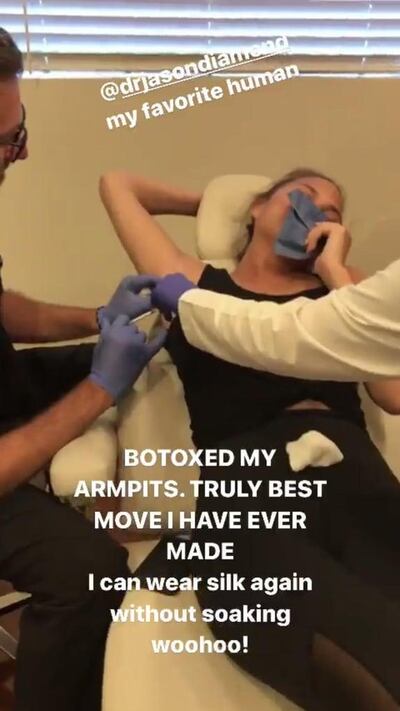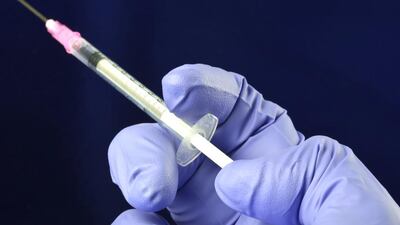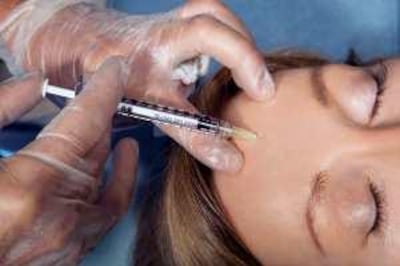We are crowning Chrissy Teigen as the queen of social media. The model and presenter doesn't hold back – not when it comes to trolling her husband John Legend, not about her disdain for Donald Trump, not even when it comes to excessive sweating.
Last month, Teigen not only admitted to having Botox, she also shared a video of the procedure with her millions of followers. But Teigen, a judge on US comedy show Bring the Funny, wasn't having Botox in the way you might expect. "Botoxed my armpits," she announced on her Instagram story. "Truly best move I have ever made."
Teigen joins a growing number of people turning to Botox to treat hyperhidrosis, or excessive sweating. It works in much the same way as cosmetic Botox, says Dr Dany Kayle of Dr Kayle Aesthetic Clinic in Dubai, by paralysing the muscles into which the protein botulin is injected.

“Botox works by blocking the release of a neurotransmitter [acetylcholine] that is responsible for the stimulation of the sweat gland,” he explains. “Multiple injections are given just under the skin, spaced apart by few millimetres, until the whole target area is covered. Once injected, the Botox will act locally on the nerve endings that are related only to the sweat glands in that area and ultimately prevent their excretion.”
Living with hyperhidrosis
Of course, everybody sweats, but about 7.5 million people worldwide are thought to suffer from hyperhidrosis. The condition causes the body to perspire beyond its normal physical need, and people may break out in heavy sweat for no apparent reason. This can happen both generally and locally, and it doesn’t just affect the underarm. “Any area with excessive sweating can be treated using this method,” says Kayle. “The most common areas treated are the armpits, palms of the hands, soles of the feet and the forehead.”
Mentally, the condition has been linked to unhappiness. A 2018 paper on the subject, published in The American Journal of Managed Care, notes: "Living with hyperhidrosis presents many challenges and impacts numerous aspects of daily life. Patients with hyperhidrosis are impacted in their social and professional lifestyles, as well as their mental and emotional health. These negative effects, which have been studied, lead to a lower quality of life in this population. Additionally, constant moisture from sweating can lead to skin maceration. This increases the risk of skin conditions such as athlete's foot and more severe conditions such as bacterial infections or pitted keratolysis."
Every body needs to produce some amount of sweat in order to remain at a safe temperature. That’s why when we exercise or spend time outdoors in the heat, we perspire more. Our skin is covered with 2.5 million eccrine glands that release liquid through our pores to cool us down. It’s an essential and natural function, so is there any harm in getting Botox to stop it? “Not at all, because we excrete sweat from the entire body’s skin surface, and the armpits, palms, soles, forehead, or indeed whichever area is treated, only constitute a small portion of the whole body’s skin surface area,” says Kayle. “The body will still sweat from the remaining untreated skin efficiently, even if we stop it doing so from [problematic] areas.”
The downside of this kind of Botox treatment, however, is pain and heightened sensitivity. Teigen told her fans that, after years of laser hair removal, she has developed a high pain threshold in the underarm area, but Dr Faisal Salim, plastic, reconstructive and cosmetic surgeon at Euromed Clinic Dubai, warns patients that it may hurt. "The procedure typically involves having some local anaesthetic cream applied, which numbs the area after a 20-minute wait. For the underarm area, the injections are well tolerated and the effects the patients receive are greatly appreciated," he says. "For the palms of the hands and the soles of the feet, the procedure is a little more painful, so these areas are less commonly treated."
This year marked a 32 per cent increase in Google searches around excessive sweating so far – perhaps as a result of the procedure becoming more accessible or because of celebrities such as Teigen being more open about the problem. But what happens if you don’t suffer from hyperhidrosis and still want to reduce the amount of sweat you produce? In that case, more caution should be taken, and patients are advised to seek the approval of a dermatologist before going ahead with the procedure.

Botox is not just for wrinkles
Over the past decade, Botox has become the world's most popular non-surgical cosmetic treatment, with more than six million procedures taking place each year. The neurotoxin is most commonly used to cosmetically treat wrinkles and crow's feet. However, there are a number of ways in which the injections can be used to treat more serious medical conditions.
"Botox has many other non-cosmetic uses such as treating muscle spasm, which can be a consequence of a medical condition such as multiple sclerosis, or which can occur as an isolated condition like a neck and shoulder spasm, for example," says Kayle. "It also showed promising results in treating migraine, tennis elbow, strabismus, blepharospasm, where patients suffer from uncontrollable winking of the eye, and plantar fasciitis, which is a painful inflammation of the connective tissues of the foot."

Whether used for cosmetic or medical reasons, Botox is not permanent. On average, it lasts between three and six months, depending on how much is administered. Over elongated periods of time, it will eventually weaken the muscle, causing each round of injections to last longer. After having the shots, it can take up to two weeks for the Botox to take effect.
Teigen is not the first celebrity to talk openly about having Botox to treat sweating. Australian journalist and bestselling author Jessica Rowe has spoken in the past about having the procedure. "I realised I had an issue when I began news-reading in my early twenties," she said. "I wish I hadn't waited until I was in my thirties to deal with it." Teigen's enthusiasm best shines through in her post when she admits the procedure has one particularly important outcome for her: "I can wear silk again without soaking. Woohoo!"







